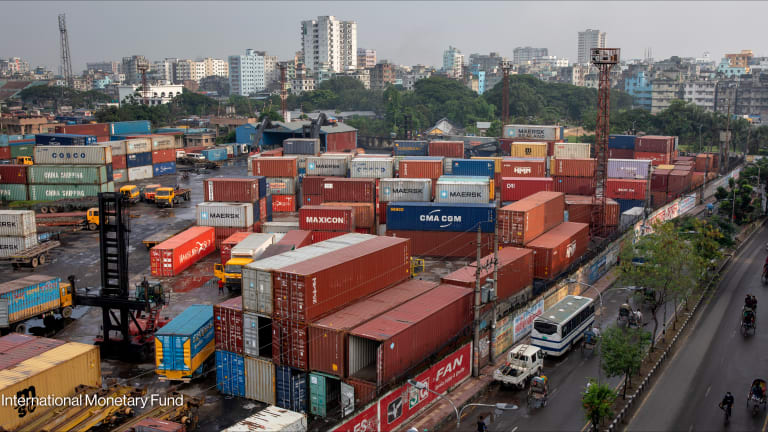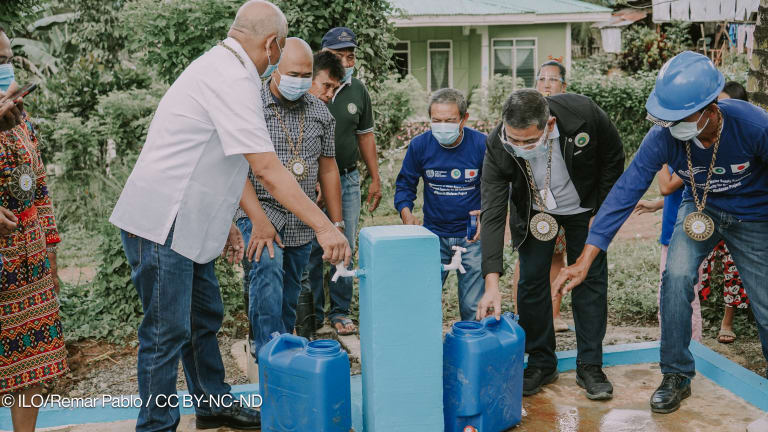Top donors to Central Asia
In this ranking of the five top donors to Central Asia, Devex finds that foreign aid to the region is characterized by strong complementarity, as each donor has chosen to concentrate the bulk of its efforts on a key sector.
Strategically located at the crossroads of Europe, Asia and the Middle East, Central Asia is home to some 50 million people living in five countries: Kazakhstan, Kyrgyzstan, Tajikistan, Turkmenistan and Uzbekistan. Often associated with natural resource wealth and low poverty rates, Central Asia however remains in the grip of complex development challenges. The region’s poor grapple with issues comparable to other parts of the world — low wages, poor living standards and food insecurity — and other fairly unique problems, such as long and harsh winters. The development of Central Asian nations is further hindered by a bleak political landscape, which is largely the result of the collapse of the Soviet bloc in 1991. Governments lack clearly set priorities for promoting a transition to an inclusive economy. Such economic and political vulnerabilities make the case for substantial aid efforts, and donors are quick to enumerate the large diversity of programs and projects they sponsor across the region. Last week, we learned that the Russian government is planning to ramp up its bilateral aid program in Central Asia — arguably part of its efforts to deepen its sphere of influence in the region. In 2013, the emerging donor provided $76.7 million to Kyrgyzstan alone, the largest recipient of Russian aid worldwide. Russia, however, is not currently among the five top donors to the region. Using aid figures for 2012, the latest year for which the Organization for Economic Cooperation and Development has detailed information on official development assistance, Devex ranked the five top donors to Central Asia and uncovered their key priorities. We found that foreign aid to the region is characterized by strong complementarity, as each top donor has chosen to concentrate the bulk of its efforts on a key sector. Asian Development Bank ($200.2 million) Disbursing $200.2 million to Kyrgyzstan, Tajikistan and Uzbekistan, the Asian Development Bank was Central Asia’s most generous donor in 2012. Confirming its strong commitment to the region, ADB cumulatively approved close to $6.5 billion of concessional loans and grants for the three landlocked countries as of December 2013. Across the Asian continent, the infrastructure deficit is substantial — and Central Asia is no exception. Kyrgyzstan, Tajikistan and Uzbekistan grapple with challenges such as poor transport connectivity, unreliable power supply and rural-urban gaps. This has led ADB to focus most of its efforts in the region on building roads, power lines, and water and sanitation systems. In 2012, infrastructure accounted for more than 65 percent of total ADB spending in these countries. A core operational area of ADB’s Strategy 2020, infrastructure is also a key investment priority of the bank’s Central Asia Regional Economic Cooperation Program, an initiative which includes 10 countries of the wider Central Asian region and aims to spur greater cross-border flows by improving transport connectivity, energy security and trade links. United States ($140 million) In 2012, official development assistance from the United States to all five Central Asian republics amounted to $140 million, making it the region’s biggest bilateral donor. Active in the region since 1992, the U.S. Agency for International Development has participated in strengthening a variety of sectors, including health systems, tuberculosis control and public finance management. A closer look at OECD data reveals that the United States is the largest supporter of democratization in Central Asia, with $53.9 million — or more than a third of its aid to the region — invested in 2012 alone to strengthen government and civil society. This confirms a long-standing U.S. trend to center aid to Central Asia on the promotion of democratization and human rights. Such a focus, however, is arguably linked to U.S. security interests aiming to avoid the emergence of political turmoil and terrorist enclaves in the region. Particularly illustrative is the fact that security system management and reform was an investment priority of democracy support in three of the five Central Asian republics (Kazakhstan, Turkmenistan and Uzbekistan). Notwithstanding U.S. foreign policy objectives, obstacles to democratic governance in Central Asia remain numerous. Various monitoring organizations such as Transparency International, Human Rights Watch and Freedom House all continue to rank Central Asian nations among the worst performers with regard to issues of corruption and human rights, with the notable exception of Kyrgyzstan. World Bank ($132. 1 million) The International Development Association — the World Bank’s lending arm for the world’s poorest nations — ranks third among Central Asia’s donors. OECD data indicates that for 2012, the IDA provided $132.1 million worth of interest-free credits and grants to Kyrgyzstan, Tajikistan and Uzbekistan. In these countries, IDA prioritized agriculture, water and energy — three sectors comprising more than half of total ODA disbursed in 2012. With the exception of Kazakhstan, the population in four of the five republics is predominantly rural, and domestic cereal production fails to meet populations’ needs. Central Asia also has some of the largest irrigation systems in the world — in some areas, up to 100 percent of cultivated land is irrigated culture — making it particularly dependent on water. Lack of investment in irrigation facilities, coupled with the drying up of vital lakes such as the Aral Sea, has left the poor particularly vulnerable to food insecurity. This has prompted the IDA to focus its funding efforts on enhancing agricultural productivity through better land and water management. Germany ($129.4 million) Germany has been funding projects in Central Asia since the early 1990s. By setting aside $129.4 million of aid for the Central Asian republics in 2012, it maintained its position as the biggest European donor to the region. A breakdown of available data shows that Germany directed $47.8 million, or more than a third of its development assistance, to education. Currently, one of the flagship programs led by the German aid agency GIZ is focused on raising educational standards in Kazakhstan, Kyrgyzstan, Tajikistan and Turkmenistan. The 1991 collapse of the Soviet economic bloc forced Central Asian nations to take charge of their own education policy and reorient education programs to the new political, economic and social conditions arising from the shift to a market economy. Yet despite these challenges, public spending on education in Central Asia remains one of the lowest levels in the world — and is even declining. According to UNESCO’s latest overview of education in Central Asia, the share of national income invested in education fell from 4 percent in 1999 to 3.2 percent in 2008, well below the world median of 5 percent. Japan ($110.6 million) By providing $110.6 million of loans and grants in 2012, Japan ranked fifth among top donors to Central Asia. Infrastructure was the backbone of Japanese development cooperation in the Central Asian region, with the Japan International Cooperation Agency allocating $45.1 million for the enhancement and construction of road and railway networks in 2012. Built during the Soviet era, much of the economic and social infrastructure in Central Asia requires renovation — a task at which JICA has been hard at work in recent years. Although Japan’s strong focus on infrastructure predominantly stems from its own experience of industrialization, it is also evidence of the international community’s wider attempts to spur growth in Central Asia through the revival of the ancient Silk Road. Check out more practical business and development advice online, and subscribe to Money Matters to receive the latest contract award and shortlist announcements, and procurement and fundraising news.
Strategically located at the crossroads of Europe, Asia and the Middle East, Central Asia is home to some 50 million people living in five countries: Kazakhstan, Kyrgyzstan, Tajikistan, Turkmenistan and Uzbekistan.
Often associated with natural resource wealth and low poverty rates, Central Asia however remains in the grip of complex development challenges.
The region’s poor grapple with issues comparable to other parts of the world — low wages, poor living standards and food insecurity — and other fairly unique problems, such as long and harsh winters. The development of Central Asian nations is further hindered by a bleak political landscape, which is largely the result of the collapse of the Soviet bloc in 1991. Governments lack clearly set priorities for promoting a transition to an inclusive economy.
This story is forDevex Promembers
Unlock this story now with a 15-day free trial of Devex Pro.
With a Devex Pro subscription you'll get access to deeper analysis and exclusive insights from our reporters and analysts.
Start my free trialRequest a group subscription Printing articles to share with others is a breach of our terms and conditions and copyright policy. Please use the sharing options on the left side of the article. Devex Pro members may share up to 10 articles per month using the Pro share tool ( ).
Manola De Vos is an Engagement Lead for Devex’s Analytics team in Manila. She leads and designs customized research and analysis for some of the world’s most well-respected organizations, providing the solutions and data they need to grow their partner base, work more efficiently, and drive lasting results. Prior to joining Devex, Manola worked in conflict analysis and political affairs for the United Nations, International Crisis Group and the EU.








